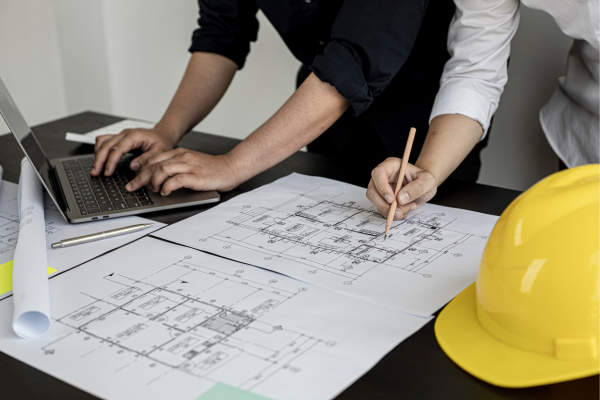
BIM Explained: Construction's Digital Revolution
Imagine building a house. Now, think of a tool that lets you see this house on a screen, inside and out, before even one brick is laid. That's Building Information Modeling, or BIM for short. It's like a superpower for those who make buildings, roads, and bridges. With BIM, they can create a digital twin of a construction project, seeing everything from how it looks to how much it costs, all before the real work begins.
Why is BIM a game-changer? First, it helps everyone involved see the same picture, reducing mistakes and misunderstandings. Imagine you're playing a team game, but everyone has different instructions. It would be chaotic, right? BIM gives everyone the same playbook. This means fewer surprises, less waste, and projects that finish on time.
Then, there's the magic of walking through a building before it's built. You can spot problems early, like a door that opens the wrong way, and fix them with a click. Plus, with BIM, you can understand how a building will live in the real world. How will it stand up to wind and rain? How much will it cost to keep it bright and warm? BIM answers these questions, helping to build not just faster, but smarter.
In short, BIM is not just about making buildings. It's about making them better, making sure they're what we need before they're built. It's about working together better and building our world more wisely.

Let's break down BIM into simpler terms, looking at its first few dimensions: 2D, 3D, 4D, 5D, 6D, 7D, and 8D.
2D and 3D BIM
Picture drawing on paper. That's 2D - length and width. It's what we've used for years to sketch buildings. Now, add depth to that picture. That's 3D, where your drawing comes to life, and you can walk around it on your computer screen. This leap from 2D to 3D in BIM is huge. It means we're not just drawing; we're building models that show every little part of a building in detail. You can see the walls, the doors, even the doorknobs. And everyone working on the project can see it too, which helps them understand exactly what they're building.
4D BIM
Now, imagine you could watch your building being built in fast-forward. That's 4D BIM. It adds time to our 3D model. This way, you can plan when each part of the building will be done. It's like telling a story of the construction before it happens. Everyone involved can see this story and know what they should do and when. It helps keep the project on track because you can see problems before they happen and fix them.
5D BIM:
What if you could also know how much each part of your building will cost as you're planning it? That's where 5D BIM comes in. It adds money into the mix. As you change your 3D model, you can see how it affects the cost. This is great because you can try different things and see how it changes your budget right away. No surprises. It helps everyone make better decisions because they know how it impacts the cost.
6D and 7D BIM
When we talk about 6D BIM, think green. It's all about making buildings that don't just stand tall but also tread lightly on our planet. This dimension brings sustainability into the picture. It helps in planning buildings that use less energy and resources. Imagine knowing how much water a building will use or how much electricity it will need before it's even built. That's 6D BIM at work, helping us build smarter for a healthier planet.
Then there's 7D BIM, which is like a building's manual for its entire life. It doesn't stop at construction; it goes on to help manage the building day-to-day. This can be anything from fixing a leak to replacing a part of the HVAC system. It's about keeping the building running smoothly and efficiently for as long as it stands. With 7D BIM, buildings are not just made; they're maintained with the future in mind, focusing on long-term care and efficiency.
8D BIM
Safety first, that's what 8D BIM is all about. It adds a layer of protection by using data to predict and prevent accidents before they happen. Imagine being able to see potential risks in a construction project and having the chance to fix them before they cause harm. That's the power of 8D BIM. It's like having a safety net that catches problems before they become accidents, ensuring that everyone involved in building and maintaining structures does so in the safest way possible. It's about building with care, ensuring health and safety standards are not just met but exceeded, protecting not just the workers but also the people who will live in and use the buildings for years to come.

The Future of Construction with BIM
Think of BIM as a bridge to the future of construction, a future where buildings and infrastructure projects come to life more efficiently, with less waste and higher quality. It's already reshaping how we approach construction projects, fostering a level of collaboration that was hard to imagine before. Teams across the globe can work on the same model in real-time, spotting and solving problems before they become costly mistakes.
But what's next is even more exciting. Imagine BIM powered by artificial intelligence (AI) and machine learning. These technologies could predict project outcomes with incredible accuracy, suggest optimizations for designs, and even automate parts of the construction process. For instance, AI could analyze a BIM model to find the most cost-effective materials that still meet the project's sustainability goals. Or it could simulate thousands of construction sequences to find the fastest, safest way to build.
We're starting to see hints of this future today. Projects are using BIM to create digital twins, perfect virtual replicas of buildings that help manage them throughout their lifecycle. And as AI gets smarter, these digital twins could predict when a building part needs maintenance before it breaks down.
This is just the beginning. As BIM evolves, it will continue to break down barriers, making the construction industry more sustainable, efficient, and innovative. The future of construction with BIM promises buildings that are not just built better but smarter, adapting to their environments and the needs of the people who use them.

Getting Started with BIM - Steps for Implementation
Here's how to get your feet wet without getting swept away by the current. First, start with a clear goal. Why are you adopting BIM? Is it for better collaboration, efficiency, or to stay competitive? Knowing your "why" will guide your "how."
Next, education is key. Look for training courses. Many are online, making it easier to fit into your schedule. These courses range from beginner to advanced, covering everything from the basics of BIM to specialized applications in different fields.
Choosing the right software is like picking the right tool for a job. Not all BIM software is created equal, and what works best will depend on your specific needs. Look for software that's widely used in your industry, as this will make collaboration with other firms easier. Don't forget to consider software compatibility, ease of use, and the level of support provided by the vendor.
Partnership is your next big step. BIM is all about collaboration, so you'll want to work with partners who are also on board with BIM. This could mean choosing contractors, architects, and engineers who are experienced with BIM projects. Their experience can be a valuable asset as you navigate your own BIM journey.
Lastly, remember that implementing BIM is a process, not a one-time event. Start small with pilot projects to build your team's confidence and expertise. Use these projects as learning opportunities to refine your BIM strategy before scaling up.
BIM isn't just a new tool; it's a revolutionary approach that's transforming the construction industry from the ground up. From the foundational 2D and 3D models that give life to ideas on screen, to the advanced dimensions like 4D for scheduling, 5D for cost estimation, and beyond into sustainability and facilities management with 6D and 7D, BIM encapsulates a project's life from conception to operation. It brings stakeholders together, enhancing collaboration, reducing waste, and driving efficiency at every stage.
The future, bright with the potential integration of AI and machine learning, promises even greater advancements, making construction smarter, safer, and more responsive to our needs. For businesses looking to adopt BIM, the journey begins with clear goals, education, the right tools, and collaborative partnerships.
This comprehensive overview, informed by insights from leading industry sources like Revizto, Autodesk, and NBS, offers a glimpse into the transformative power of BIM. It's not just about building better; it's about building smarter, with foresight and sustainability at the core of every project. As we look ahead, BIM stands as a beacon of innovation in construction, reshaping our built environment for the better.
Ready to Transform Your Construction Projects? Visit bidlight.com.